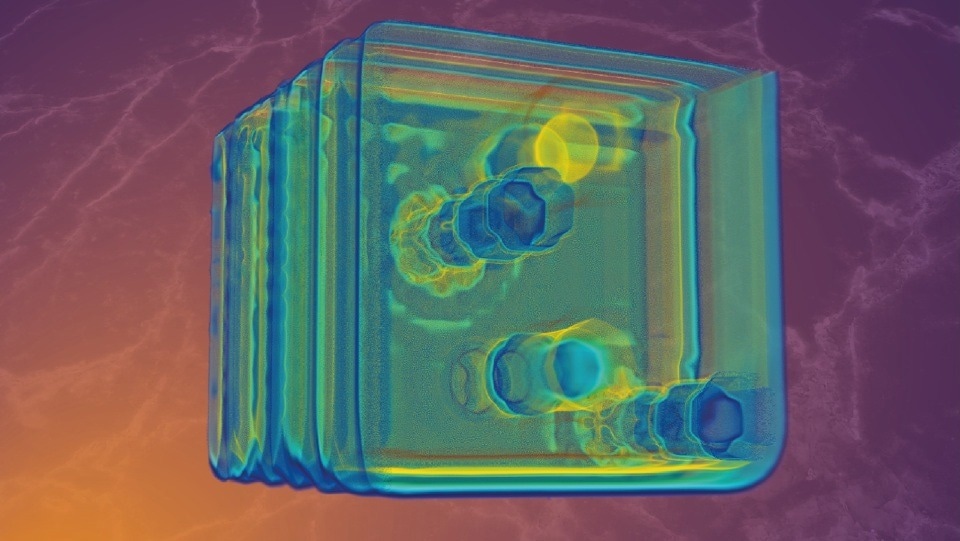Scientists from Loughborough University are the first to show how a terahertz wave camera can record 3D images of minuscule things concealed inside small objects.

Microscopic, metallic objects distributed throughout a 3D cube. Metallic objects were imaged using the terahertz wave camera and then combined with an artistic, rendered image. Image Credit: Loughborough University
Although the study is still in its early stages, lead researcher Dr. Luana Olivieri claims it could have “major implications for a range of fields with relevance in cancer screenings, security, and materials research.” The study was primarily funded by the ERC Horizon 2020 Research and Innovation program.
The study shows that terahertz waves can be used to find and recognize embedded objects and features, such as cracks and bubbles, in microscopic three-dimensional space.
It was conducted in collaboration with Professor Marco Peccianti, Dr. Luke Peters, Dr. Juan S. Totero, and a group of specialists from the Emergent Photonics Research Centre (EPicX). The study was presented in the ACS Photonics journal and is featured on the cover of the most recent issue, which was released on June 21st, 2023.
With wavelengths between microwave and infrared light, terahertz waves are a mostly unknown region of the electromagnetic spectrum. They possess various qualities that make them extremely helpful, such as the capacity to pass through solid objects without harm.
However, the restricted ability to view small objects is one of the key issues in the field of terahertz imaging.
By creating a special technique known as “time-resolved nonlinear ghost imaging,” which combines several modern detection techniques and involves manipulating light and monitoring how it passes through an object over time, Dr. Olivieri and the EPicX team have circumvented this constraint.
Although their approach has only been tested on 2D objects thus far, it makes smaller objects easier to see.
In their most recent study, the researchers demonstrated that the method could capture 3D images of microscopic objects by probing cubes with terahertz radiation that are 4 mm by 4 mm by 600 µm (microns) in size.
With the aid of their imaging technology, the researchers were able to separate and discriminate data from various depths and produce precise, comprehensive 3D images of the cubes, enabling them to analyze the chemical and physical properties of the contents in a way that was previously impossible.
At 60 microns, or about the width of a human hair, Dr Olivieri and his team were able to detect characteristics that were concealed inside the cubes.
Although it may not appear to be very small, terahertz waves typically can only recognize objects that are 300 microns or larger, which is why terahertz was previously excluded from microscopy.
This new approach is enabling because it allows us to see things that are too small or too obscured to be within reach of traditional methods.
Dr. Luana Olivieri, Lead Researcher, Loughborough University
“Reading the story of how light has traveled through an object is often a complex task, but with this process, we can retrieve the information encrypted, unraveling the multidimensional data to unveil hidden and ‘invisible’ objects at the microscale. Most importantly, terahertz allows us to see through objects that are not transparent with visible light and produce 3D images,” Dr. Olivieri further stated.
Dr. Luke Peters from the Emergent Photonics Research Centre added, “In medicine, terahertz imaging could be used to detect and diagnose skin cancers that are not visible to the naked eye. In security, it could be used to improve the resolution of scanners that are used to search people for concealed weapons or explosives, without the need for physical pat-downs or intrusive searches.”
He further added, “And in materials science, terahertz imaging could be used to study the properties of new materials and identify defects or impurities that may affect their performance. Our work allows us to expand these capabilities into the microscopic domain. I am enthusiastic about the potential benefit for society.”
Professor Peccianti, director of EPicX, commented: “This work was developed as part of the Emergent Photonics Research Centre at Loughborough University, whose scope is to assemble a critical core of scientists around major technological-economic and societal challenges and approach them through photonics and terahertz technologies.”
Journal Reference
Olivieri, L., et al. (2023) Terahertz Nonlinear Ghost Imaging via Plane Decomposition: Toward Near-Field Micro-Volumetry. ACS Photonics. doi:10.1021/acsphotonics.2c01727.